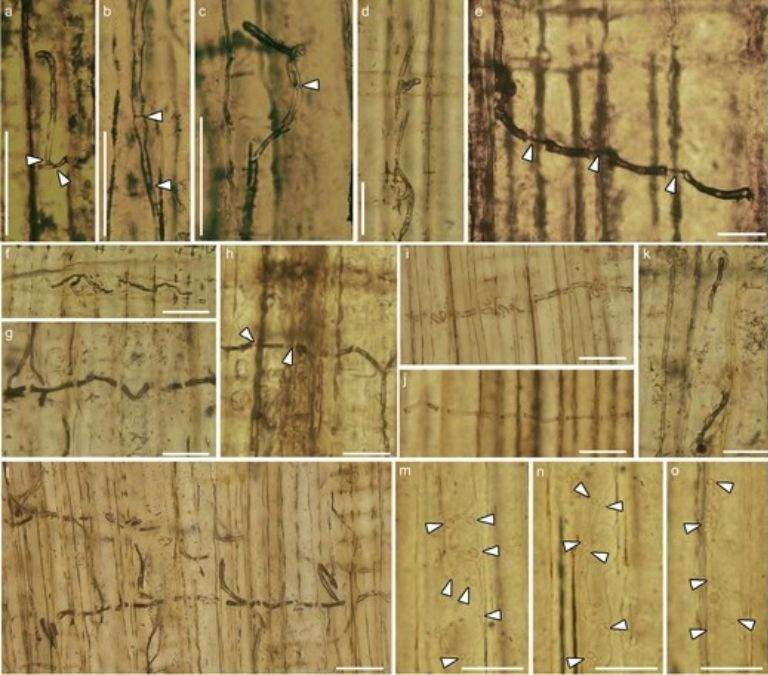A Chinese research team led by Dr. Ning Tian and Dr. Yongdong Wang (Nanjing Institute of Geology and Palaenology, CAS), in a groundbreaking discovery, came across 160-million-years-old, well-preserved fungal hyphae preserved within a Jurassic fossil wood from northeastern China.
The discovery of well-preserved blue-stain fungal hyphae within a Jurassic fossil wood from northeastern China rewrites the evolutionary timeline of blue-stain fungi and extends the fossil record of this fungal group by approximately 80 million years.
"Not until 2022, the first credible fossil record of blue-stain fungi was reported from the Cretaceous in South Africa with an age of approximately 80 million years," says Dr. Ning Tian from Shenyang Normal University in Shenyang, China.
The findings from the blue-stain fungi fossils from the Jurassic Tiaojishan Formation in China will help understand the ecological relationships between blue-stain fungi, plants, and insects during the Jurassic period.
In this article, we will understand what blue-stain fungi is and why it is harmful for trees.
What is blue-stain fungi?
Blue-stain Fungi are a group of wood-colonising fungi that cause a characteristic discolouration in the sapwood of trees, often appearing as blue or greyish-black stains.
The blue-stain fungi form a polyphyletic group consisting of several genera within the class Sordariomycetes of Ascomycota. Molecular phylogenetic analyses show that blue-stain fungi are an ancient group; suggesting Sordariomycetes diverged from other Ascomycota during the Late Paleozoic to early Mesozoic.
They are primarily found in coniferous trees and are not wood-decomposing. This means these fungi are non-fatal to their hosts and don't destroy the wood's structural components (lignocellulose) itself, but their presence can accelerate tree mortality. when associated with wood-boring insects, such as pine bark beetles.
They can grow in living ray parenchyma or phloem cells, and they can also decompose wood resins and waxes in resin ducts, particularly in conifers.
160-million-year-old blue stain discovered in China

Image: Blue-stain fungus in wood tissues of Xenoxylon phyllocladoides Gothan from the Jurassic of western Liaoning Province, NE China
The discovery in the news is a 160-million-years-old fossil blue-stain fungus colonising an insect-infested conifer wood Xenoxylon phyllocladoides from the Jurassic Tiaojishan Formation in western Liaoning Province, Northeast China.
Microscopic examination of the wood host shows the presence of wood-boring holes, meaning it was once infected by wood-consuming insects. The hyphae, found in both the ray parenchyma cells and the tracheid lumen, is exhibiting a distinct dark colouration.
Why is it harmful for trees?
Blue-stain fungi harm trees primarily by causing sapwood discolouration causing a characteristic blue or greyish stains and accelerating tree mortality when associated with wood-boring insects.
The discolouration is a result of the fungi producing melanins in their cells. While the discolouration doesn't directly reduce the wood's strength, it can reduce the aesthetic value of the wood for certain applications.
The highly acidic environment caused by the blue-stain fungi makes the wood more susceptible to decay fungi that thrive in acidic conditions.
These fungi can also block the flow of water and nutrients in the tree, thus weakening it.
By damaging the tree's ability to transport water and nutrients, blue stain fungi can contribute to tree stress and make it more vulnerable to other threats and also pests and diseases.
In summary, blue-stain fungi accelerate tree mortality, and when associated with wood-boring insects, the consequences are more fatal for trees.
Also read: Top 10 Countries With Highest Oil Consumption In 2025
Comments
All Comments (0)
Join the conversation